BMP5
-
Official Full Name
bone morphogenetic protein 5
-
Overview
This gene encodes a member of the bone morphogenetic protein family which is part of the transforming growth factor-beta superfamily. The superfamily includes large families of growth and differentiation factors. Bone morphogenetic proteins were originally identified by an ability of demineralized bone extract to induce endochondral osteogenesis in vivo in an extraskeletal site. These proteins are synthesized as prepropeptides, cleaved, and then processed into dimeric proteins. This protein may act as an important signaling molecule within the trabecular meshwork and optic nerve head, and may play a potential role in glaucoma pathogenesis. This gene is differentially regulated during the formation of various tumors. -
Synonyms
BMP5; bone morphogenetic protein 5; BMP-5; MGC34244;
- Recombinant Proteins
- Cell & Tissue Lysates
- GMP Proteins
- Protein Pre-coupled Magnetic Beads
- Chicken
- Human
- Mouse
- Zebrafish
- CHO
- E. coli
- E.coli
- HEK293
- Human Cell
- In Vitro Cell Free System
- Mammalian Cell
- Mammalian cells
- Wheat Germ
- C
- His
- Fc
- GST
- hFc
- His (Fc)
- Avi
- His(C
- ter)
- N/A
- Background
- Quality Guarantee
- Case Study
- Involved Pathway
- Protein Function
- Interacting Protein
- BMP5 Related Articles
- BMP5 Related Gene Family
- BMP5 Related Research Area
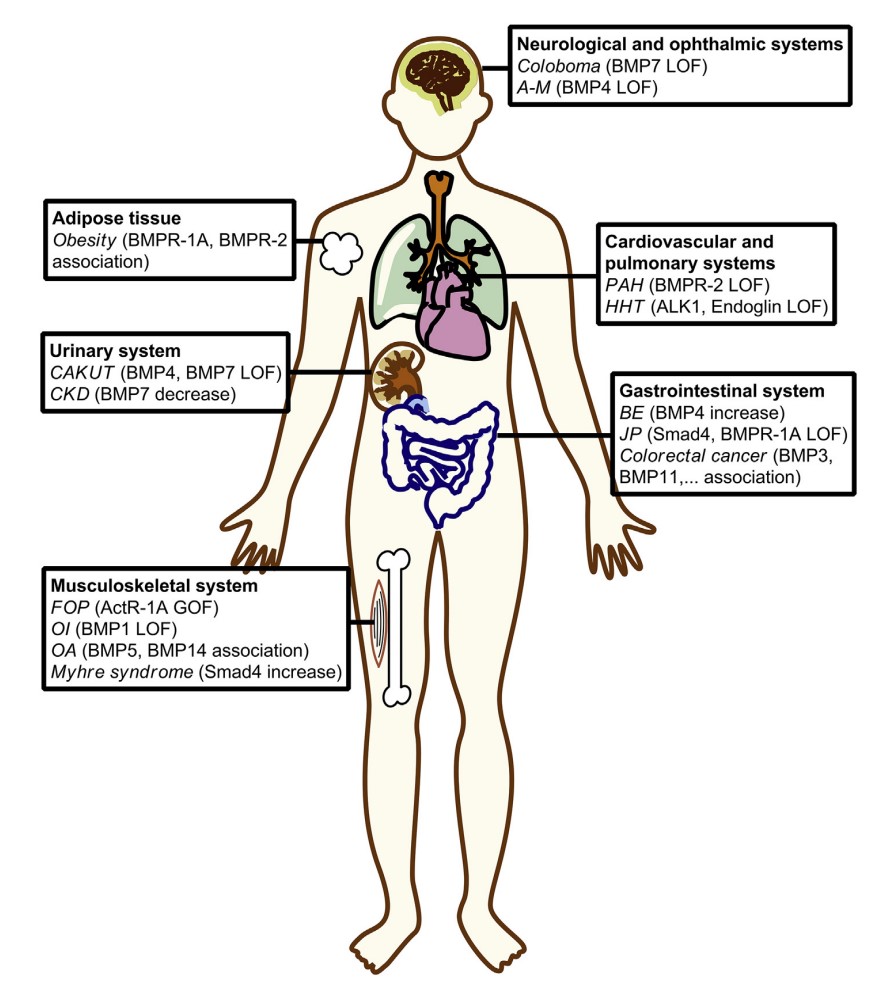
Fig1. Representative members of the BMP signaling pathway that have been demonstrated to cause or be associated with human diseases. (Richard N Wang, 2014)
What is BMP5 protein?
BMP5 (bone morphogenetic protein 5) gene is a protein coding gene which situated on the short arm of chromosome 6 at locus 6p12. This gene encodes a member of the bone morphogenetic protein family which is part of the transforming growth factor-beta superfamily. The superfamily includes large families of growth and differentiation factors. Bone morphogenetic proteins were originally identified by an ability of demineralized bone extract to induce endochondral osteogenesis in vivo in an extraskeletal site. These proteins are synthesized as prepropeptides, cleaved, and then processed into dimeric proteins. This protein may act as an important signaling molecule within the trabecular meshwork and optic nerve head, and may play a potential role in glaucoma pathogenesis. The BMP5 protein is consisted of 454 amino acids and its molecular mass is approximately 51.7 kDa.
What is the function of BMP5 protein?
BMP5 is a growth factor of the TGF-beta superfamily that plays essential roles in many developmental processes, including cartilage and bone formation or neurogenesis. It initiates the canonical BMP signaling cascade by associating with type I receptor BMPR1A and type II receptor BMPR2. In turn, BMPR1A propagates signal by phosphorylating SMAD1/5/8 that travel to the nucleus and act as activators and repressors of transcription of target genes. BMP5 can also signal through non-canonical pathway such as MAPK p38 signaling cascade to promote chondrogenic differentiation. It can also promote the expression of HAMP which is repressed by its interaction with ERFE.
BMP5 Related Signaling Pathway
BMP5 can activate the PI3K/Akt signaling pathway by activating BMP receptors. BMP5 can activate the JNK (c-Jun N-terminal kinase) signaling pathway by activating both SMAD-dependent and non-dependent signaling pathways. Or form complexes with activated Smad proteins that bind to Smad4 into the nucleus and regulate the transcription of target genes. At the same time, there is cross-regulation between BMP5 and Wnt signaling pathways.
BMP5 Related Diseases
Mutations or abnormalities in the function of BMP5 can lead to developmental defects in the heart, such as ventricular septal defects and patent ductus arteriosus. Defects in BMP5 may lead to abnormal bone development, such as impaired fracture healing and decreased bone density. The abnormal expression of BMP5 may be related to the occurrence and development of cataract.
Bioapplications of BMP5
By combining BMP5 with scaffolds, tissue engineered bone with good biocompatibility and osteogenic activity can be prepared for repairing bone defects. In addition, BMP5 can also be used in cartilage tissue engineering, periodontal tissue regeneration and other aspects. BMP5 gene therapy is a new therapeutic method, by introducing BMP5 gene into target cells, it makes them express BMP5 protein in vivo, so as to play a therapeutic role.
High Purity
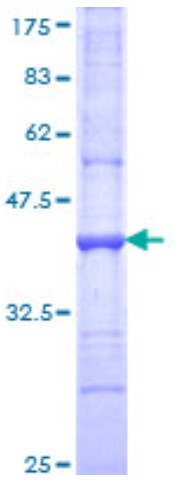
Fig1. SDS-PAGE (BMP5-269H) (PROTOCOL for western blot)
.
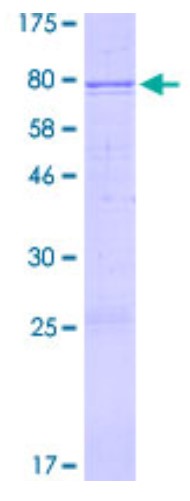
Fig2. SDS-PAGE (BMP5-268H) (PROTOCOL for western blot)
Case study 1: Lijun Zhang, 2015
Fibroblast activation and proliferation are important for fibroblast-myofibroblast transdifferentiation, a crucial process in the pathological changes that define renal interstitial fibrosis. The left-right determination factor (Lefty) is an important cytokine of the transforming growth factor (TGF)-β family, with two variants, Lefty-1 and Lefty-2, in mice which can inhibite the TGF-β1 signaling. However, whether Lefty-1 influences fibroblast activation and proliferation, and consequently prevents fibroblast-myofibroblast transdifferentiation, remains unclear.
This study aimed to investigate whether Lefty-1 can attenuate TGF-β1-induced fibroblast-myofibroblast transdifferentiation in normal rat kidney interstitial fibroblast cells (NRK-49F), as well as the mechanisms underlying any effects. The results show lefty-1 induced remarkable reductions in TGF-β1-induced Smad3 and mitogen-activated protein kinase-10/c-Jun N-terminal kinase (JNK-3) signaling, and enhanced expression of the antifibrotic factor bone morphogenetic protein (BMP)-5. However, without TGF-β1, Lefty-1 had no effect on Smad3, JNK-3, and BMP-5 activation and fibroblast-myofibroblast transdifferentiation. These findings indicate that Lefty-1 may prevent fibroblast-myofibroblast transdifferentiation in part via modulations of Smad3, JNK-3, and BMP-5 activities in the TGF-β/BMP signaling pathway.
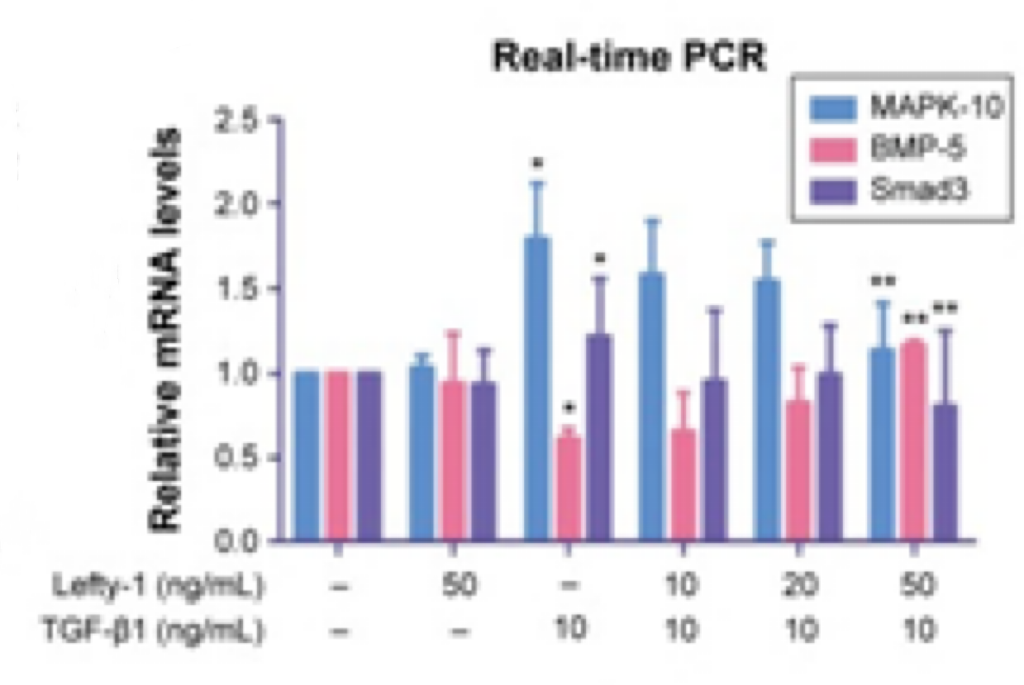
Fig1. Lefty-1 modulates TGF-β/BMP signaling pathway in NRK-49F cells. Real-time PCR further validated that these results are consistent with gene microarray findings.
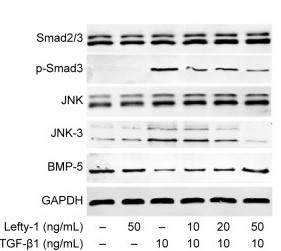
Case study 2: Erfei Chen, 2018
Although the genetic spectrum of human colorectal cancer (CRC) is mainly characterized by APC, KRAS and TP53 mutations, driver genes in tumor initiation have not been conclusively demonstrated. In this study, the researchers aimed to identify novel markers for CRC.
The team performed exome analysis of sporadic colorectal cancer (sCRC) coding regions to screen loss of function (LoF) mutation genes, and carried out systems-level approaches to confirm top rank gene in this study. BMP5 immunohistochemistry was performed on tumor microarrays (TMAs). Western blots and immunofluorescence staining were probed with the following antibodies anti-BMP5. The wild type and mutant BMP5 expression vector were constructed for stable BMP5 overexpression and tumor formation. The result support a novel concept that the importance of BMP5 in sCRC. The tumor suppressor role of BMP5 highlights its crucial role in CRC initiation and development.
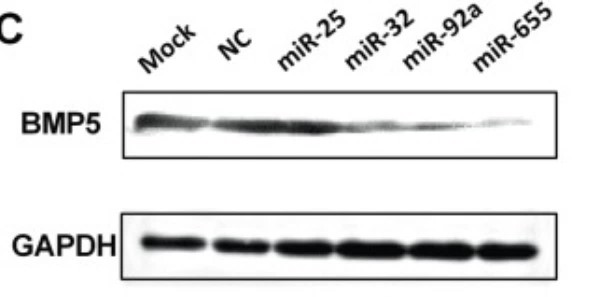
Fig3. miR-32, miR-92a, and miR-655 inhibit the protein levels of BMP5 in SW480 cells.

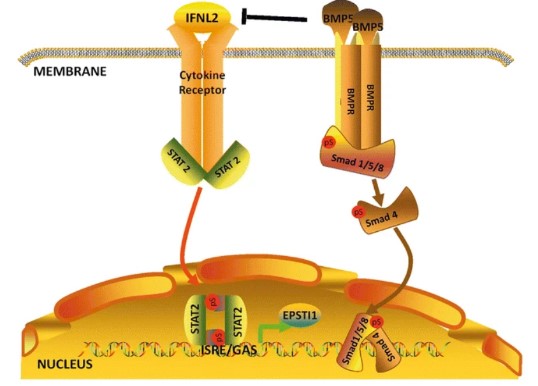
Fig1. Schematic model of BMP5-induced inhibition of Jak-Stat signaling pathway. (Erfei Chen, 2018)
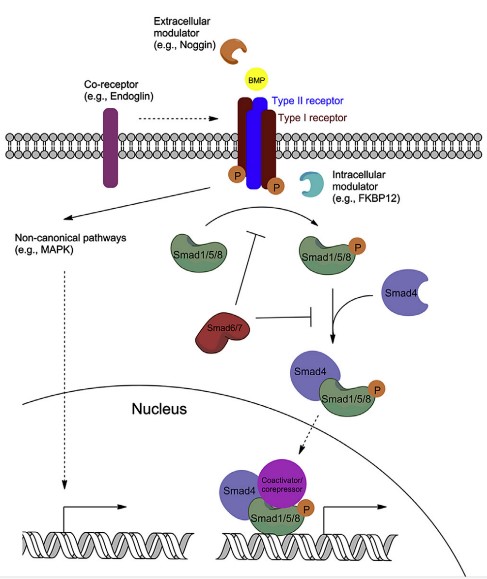
Fig2. BMPs signal via the canonical, Smaddependent pathway or various non-canonical pathways. (Richard N Wang, 2014)
BMP5 involved in several pathways and played different roles in them. We selected most pathways BMP5 participated on our site, such as TGF-beta signaling pathway, Hippo signaling pathway, which may be useful for your reference. Also, other proteins which involved in the same pathway with BMP5 were listed below. Creative BioMart supplied nearly all the proteins listed, you can search them on our site.
| Pathway Name | Pathway Related Protein |
|---|---|
| TGF-beta signaling pathway | FSTA;ACVR1;TGFBR2;ROCK1;BMPR2;BMPR2B;SMAD3A;ID3;GDF6A |
| Hippo signaling pathway | LATS2;CTGF;SCRIB;MOB1A;LLGL2;AREG;SOX2;WNT1;WNT7B |
BMP5 has several biochemical functions, for example, BMP receptor binding, cytokine activity, growth factor activity. Some of the functions are cooperated with other proteins, some of the functions could acted by BMP5 itself. We selected most functions BMP5 had, and list some proteins which have the same functions with BMP5. You can find most of the proteins on our site.
| Function | Related Protein |
|---|---|
| BMP receptor binding | BMP2B;BMP8B;BMP7A;BMP4;BMP2;BMP3;BMP7B;BMP6;BMP8A |
| cytokine activity | CXCL9;IL9;INHBA;BMP15;GDF10;HMGB1B;MIF;SCGB3A1;Ccl27a |
| growth factor activity | IGF2A;Il2;FGF13A;ANGPTL3;INHBA;EGF;INHBB;BMP2B;GDNFA |
| transforming growth factor beta receptor binding | LEFTY1;NODAL;GDF7;LFT1;NDR2;BMP10;USP15;BMP2;SMURF2 |
BMP5 has direct interactions with proteins and molecules. Those interactions were detected by several methods such as yeast two hybrid, co-IP, pull-down and so on. We selected proteins and molecules interacted with BMP5 here. Most of them are supplied by our site. Hope this information will be useful for your research of BMP5.
- Q&As
- Reviews
Q&As (7)
Ask a questionBMP5, a member of the bone morphogenetic protein family, functions by binding to cell surface receptors and activating the Smad signaling pathway. This leads to the phosphorylation and nuclear localization of transcription factors, thereby regulating gene expression. BMP5 plays a crucial role in cellular proliferation, differentiation, and fate determination. Its signaling mechanism involves various molecular regulations, including the involvement of co-receptors, signal transduction mediators, and downstream effectors.
BMP5 regulates the expression of various downstream target genes involved in multiple cellular processes. These include genes encoding transcription factors, extracellular matrix components, growth factors, and signaling molecules. Examples of BMP5 target genes include Runx2, Osterix, Sox9, Noggin, and Gremlin. Through the activation of these target genes, BMP5 influences cell fate determination, osteoblast differentiation, chondrogenesis, and tissue homeostasis.
BMP5 plays a critical role in skeletal development and bone formation. It promotes the commitment of mesenchymal stem cells to the osteoblast lineage and stimulates their differentiation into mature osteoblasts. BMP5 also regulates the proliferation and survival of osteoblasts, as well as the synthesis and mineralization of the extracellular matrix. Additionally, BMP5 interacts with other BMP family members and signaling molecules to coordinate the complex processes of skeletal patterning, limb development, and bone remodeling.
Dysregulation of BMP5 expression or signaling has been implicated in various skeletal disorders, including osteoporosis, osteoarthritis, and skeletal dysplasias. BMP5 mutations or alterations in its expression levels can disrupt normal bone development and contribute to skeletal abnormalities. Additionally, BMP5 has been found to play a role in cancer progression. Depending on the context, BMP5 can act as either a tumor suppressor or a promoter by influencing cell proliferation, apoptosis, angiogenesis, and metastasis.
Despite significant progress, several challenges remain in BMP5 research. Understanding the precise mechanisms underlying BMP5 signaling and its cross-talk with other signaling pathways is crucial. Additionally, investigating the context-dependent functions of BMP5 in different tissues and disease conditions is important for developing targeted therapies. Future research should focus on elucidating the regulatory networks controlling BMP5 expression and identifying novel therapeutic targets within the BMP5 signaling pathway. Moreover, studying the potential of BMP5 as a diagnostic or prognostic marker in various diseases would further expand its clinical relevance.
The expression of BMP5 is tightly regulated through a combination of transcriptional, post-transcriptional, and post-translational mechanisms. Transcription factors, such as Smads, homeobox proteins, and other tissue-specific regulators, bind to the promoter region of the BMP5 gene, modulating its expression. Additionally, microRNAs and RNA-binding proteins can influence the stability and translation of BMP5 mRNA. Furthermore, epigenetic modifications, including DNA methylation and histone acetylation, play a role in regulating BMP5 expression during development and in response to environmental cues.
Targeting BMP5 signaling holds therapeutic potential for various diseases. For example, in bone-related disorders, modulating BMP5 activity could be explored to promote bone regeneration or inhibit excessive bone loss. In cancer, therapeutic strategies targeting BMP5 signaling could be designed to regulate tumor growth, metastasis, or sensitize cancer cells to existing therapies. However, further research is needed to fully understand the complex role of BMP5 in disease pathogenesis and to develop targeted therapies that specifically modulate BMP5 activity.
Customer Reviews (3)
Write a reviewRevolutionizing the art of experimentation, this reagent blazes a trail of innovation.
By using this reagent, I am able to delve deeper into my research topics, deriving more persuasive conclusions.
The reagent showcases remarkable versatility and unwavering stability when it comes to the manipulation of intricate samples.
Ask a Question for All BMP5 Products
Required fields are marked with *
My Review for All BMP5 Products
Required fields are marked with *


